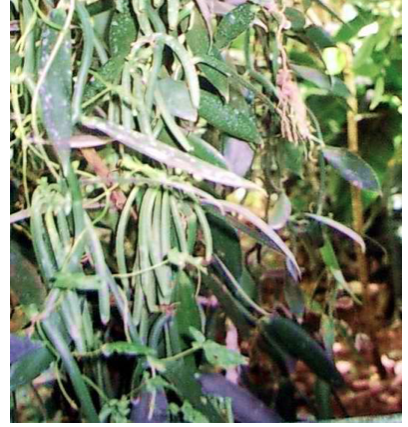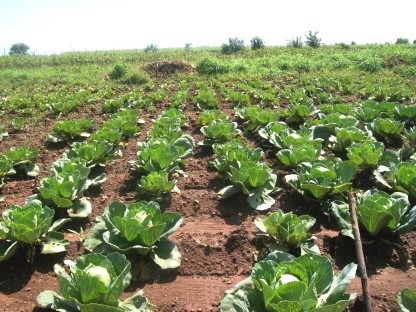
Scientist
By Dr. Ulrich Berk (Germany)
In the last article we summarized four M.Sc. theses from Dharwad University, Karnataka, India, which give ample evidence that with Homa Organic Farming a healthy micro-flora and micro-fauna in soil is created, thus rejuvinating the soil. This is of utmost importance as nowadays conventional farming which uses a wide range of agrochemicals is destroying this micro-flora and micro-fauna, thus leaving behind a soil which is more and more exhausted, no longer a rich living soil. Production comes down and even the supply of food for humanity is at stake, as reports from FAO, the Food and Agriculture Organization of the United Nations state.
A healthy soil is the capital for future generations to grow enough food, it is an investment in the future so to say.
But equally important is production of enough food of good quality to feed the present population. How does Homa Organic Farming help with that? The four M.Sc. theses mentioned above also examined this question. Plants grown were soybeans, tomatoes, cabbage, and okra.
Morphological characteristics and Yield parameters
The following table shows a significant increase in yield parameters.
We compare Homa Organic Farming (including seed treatment and application of Homa Biosol to plants and soil) with farming without Homa as control.

The table shows clearly that both morphological characteristics and yield improved considerably. These results you get when all methods of Homa Organic Farming are followed, including the treatment of seeds, foliar and soil application of Homa Biosol, and also spraying Agnihotra Ash water.
One of the results I want to mention especially: The development of root nodules in soybeans. Such nodules we find in leguminous plants like clovers, alfalfa, lupines, and peanuts besides soybeans.
Nitrogen-fixing bacteria enter the roots of these legumes and multiply, thus forming root nodules.
In these nodules nitrogen gas from the atmosphere (which is easily available there as 78% of our atmosphere is nitrogen) is fixed and made available to plants. When these plants die, the remaining nitrogen remains in the soil, thus improving soil quality and helping growth of plants in the next season. This is of great importance as nitrogen is often the limiting nutrient.
How Homa Organic Farming (including the use of Homa Biosol) helps with the formation of root nodules becomes evident by the following photos.
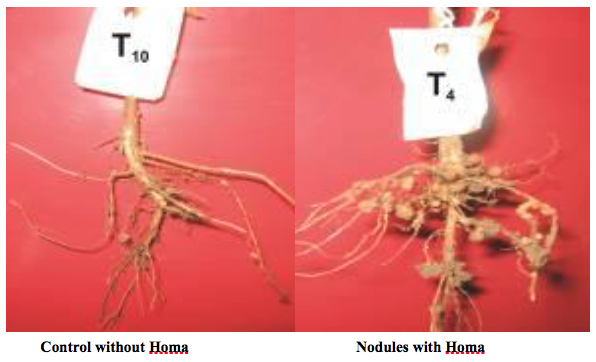
The four M.Sc. theses done at Dharwad University, Karnataka, India, also showed good effects of Homa Organic Farming on quality parameters of the foods grown and regarding reduction of pests and diseases. This will be discussed later.

Scientist
By Dr. Ulrich Berk (Germany)
Vedic Knowledge says that when we perform Agnihotra, a channel is created above the pyramid, going up12 kilometres.
Prana energy – Life Energy – which lies above our atmosphere comes down through this channel. Because of pollution this flow of Prana energy might be blocked otherwise.
When the Prana reaches the Agnihotra pyramid it creates an Aura energy field around all plants in the vicinity which lasts as long as the flame is there.
This makes plants stronger and disease resistant.
Also it is said that Agnihotra brings Nature back to Harmony.
Can these statements be confirmed by modern science?
There are many reports from people who have experienced that pests and diseases got controlled in their gardens and farms. The first systematic studies done by agricultural engineers were done approximately 20 years ago in South America, mainly in Peru. A fungal disease Black Sigatoka affected banana plantations on large scale, destroying up to 90% of the crops. This was especially severe as in South America banana is a staple food for most of the population. Chemical remedies did not work for more than one season – after that the fungal population had become resistant against these fungicides. Many farmers were about to give up their banana plantations, and on one of these farms Homa Organic Farming was started using the resonance technique (in which ten Agnihotra pyramids are energized and arranged in a special configuration so that by resonance a large area up to 80 hectares can be covered). According to reports of government engineers Black Sigatoka infection could be totally eradicated:
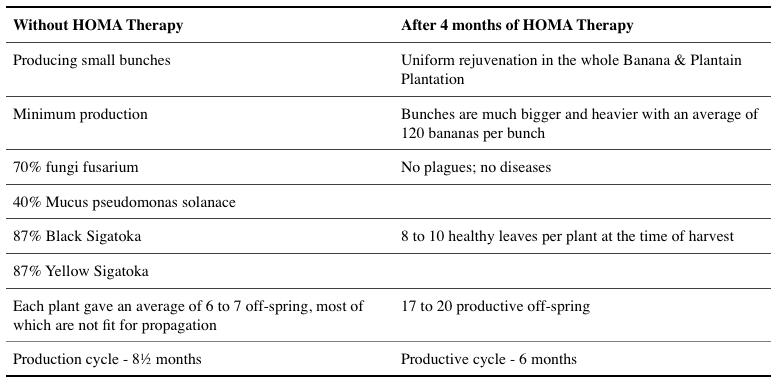
There were some quite astonishing reports of how Homa Organic Farming methods have helped to control diseases and pest infestation. I just want to mention two of those before going to some systematic studies on the subject.
The first report was from Karin Heschl about tomatoes in Jaipur area, India. Farming was done with agrochemicals, and the tomatoes were heavily infested with tomato fruit borer.
All the tomato farms in the village were affected. Heavy doses of chemical insecticide were needed 3 times per week.
In one farm Homa Farming was started. After three months of treatment with Homa Therapy the pest infestation was completely controlled.
The subsequent plantings after beginning Homa Therapy treatment were not infested at all.
Also the yield was double that of the other farmers in the village.
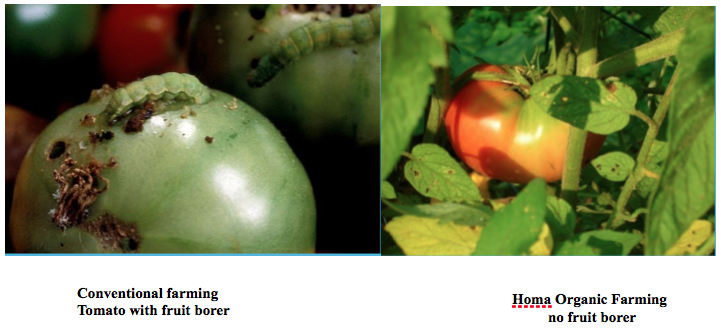
The second report came from Abhay Mutalik Desai, a Homa Organic Farmer from Belgaum area, Karnataka, India. He was growing sugar cane for several years with Homa Farming methods on a 20 acre farm and got good results.
Then in 2005, his plants were surprisingly attacked by woolly aphid. As this should not have happened he checked whether the Homa Farming methods were done properly on the farm and found out that the farm manager had bought ghee from the market which was not pure cow’s ghee. Immediately he got pure cow ghee (and then bought some cows for the farm so that they could produce their own ghee). Immediately after the Homa fires were done with proper ghee two natural predators – Micromus igorotus and Dipha aphidivora – came automatically and controlled the woolly aphid, and again they had lush, green, healthy sugar cane.
Interestingly, the predators started from the area where the woolly aphid had first appeared.
This two examples show how Homa Farming helps to bring Nature back to Harmony.
Later on more systematic research on the effects of Homa Organic Farming on pests and diseases was conducted in India. We already had mentioned four M.Sc. studies done at the Agricultural University in Dharwad, Karnataka, India, and last time we reported the results regarding yield of soy beans, cabbage, tomatoes, and okra. Now let us see the results regarding diseases and pests.
Soy beans
- Decrease in the incidence of rust (16-29%) and insect attack (18-43%) were observed due to different Homa treatments.
- Foliar application of Biosol was found to be effective in the control of rust, pod borer and the control of caterpillar.
Cabbage
- Decrease in the incidence of black rot (29-55%) and black spot of leaf (39-73%), head borer (18-69%), number of diamond back moth larvae per plant (25-64%) and Spodoptera litura larvae per plant (40-62%) were observed due to different homa treatments as compared with organic control not exposed to homa treatment but organic control with homa and conventional control did not differ significantly.
Tomatoes
- Decrease in the incidence of leaf spot (37%) and insect attack (40%) was observed as compared with Gloria Biosol and organic control due to different homa treatments.
Okra
- Decrease incidence of Powdery mildew (19-36%) and Alterneria leaf spot (30-57%), fruit borer (16-38%), and Spodoptera litura larvae per plant (48-68%) were observed due to different homa treatments as compared with conventional control.
These studies show significant reduction in pest infestation and in diseases. The areas of Homa Farming and control were approximately one kilometre apart – which may not be enough to exclude some positive effect of the Homa atmosphere also in the control area. Normally we advise to have these two plots at least three kilometres beeline apart. But even as this distance was not kept they good convincing results.

Scientist
By Dr. Ulrich Berk (Germany)
For good health proper diet with nutritious vegetables, fruits, and grains is of great importance. But it seems that with the food produced nowadays our bodies often do not get all the micronutrients they need to maintain good health. Several recent studies show that there is a decline in nutritional value of vegetables, fruits, and grains.
A Scientific American article summarizes several such studies which compare the nutrient levels of food nowadays with tables of nutrient content 50 to 70 years ago.
One study showed that average calcium levels in 12 fresh vegetables dropped 27 percent; iron levels 37 percent; vitamin A levels 21 percent, and vitamin C levels 30 percent. Another study comparing nutrient levels of 20 vegetables found that the average calcium content had declined 19 percent; iron 22 percent; and potassium 14 percent. Yet another study concluded that one would have to eat eight oranges today to derive the same amount of Vitamin A as our grandparents would have gotten from one. (See: www.scientificamerican.com/article/soil-depletion-and-nutrition-loss)
Other studies cited by Worldwatch Institute report that today’s food produces 10 to 25 percent less iron, zinc, protein, calcium, vitamin C, and other nutrients. Researchers from Washington State University who analyzed 63 spring wheat cultivars grown between 1842 and 2003 found an 11 percent decline in iron content, a 16 percent decline in copper, a 25 percent decline in zinc, and a 50 percent decline in selenium.
(http://www.worldwatch.org/node/5339)
The decline of nutritional value of our foods not only refers to minerals and vitamins. There is also a loss in phytonutrients, most of them less known to most of us – but they play an important role for preventing disease and maintaining good health.
These plant extracts show antioxidant, bactericidal, and antimicrobial effects.
A lack of nutrition in our foods leads to a number of diseases and ailments.
Human health conditions such as chronic coronary thrombosis, hypertension, diabetes, osteoporosis, cancer, old age, and lifestyle-related diseases are associated with the diet. Declining food quality can thus be one reason why such lifestyle diseases are increasing in the last decades.
Several theories have been suggested to explain the decline in food quality. The main reasons for that seem to be:
- Soil depletion (remember – we have talked about that subject earlier)
- Changes in cultivated varieties: nowadays are mostly growing high-yielding varieties which are less nutritious than the plants being used earlier.
Agrochemicals used in conventional farming: a 2001 review study, published in the Journal of Alternative and Complementary Medicine, shows that nutrient levels, including vitamin C, are lower in crops grown with chemical fertilisers. Organic spinach, lettuce, cabbage and potatoes showed relatively high levels. Commenting on this study one scientist explained: „Unlike minerals, vitamins and antioxidants are not supplied by the soil, so you cannot add them using fertilisers. They are produced by the plants themselves and are natural pest-defence compounds, part of a range of chemicals we are just beginning to understand. Studies have shown that levels are up to 40 per cent higher in organic produce. If you’re using artificial pesticides, plants don’t have to produce these protective chemicals. Levels in non-organic foods are likely to be lower.“ ( From The Guardian, https://www.theguardian.com/lifeandstyle/2005/may/15/foodanddrink.shopping3)
Now let us see whether Homa Farming has a positive effect on the nutritional value also. Again we find a lot of information in the four M.Sc. theses done at Dharwad Agricultural University (Karnataka, South India). Homa Farming methods were compared with organic methods (without Homa) and with conventional farming methods. The crops planted were soy beans, cabbage, tomatoes, and okra. (Okra is also known as ladies’ fingers, a
vegetable quite popular in Asian and African countries.)
Results were as follows:
Soy beans
5% increase in protein content.
9,5% increase in oil content.
Enzymes
-Amylase was increased by 35% compared to control in unsprouted seeds. After germination this increase went up to 66%.
Invertase was increased by 45% compared to control in unsprouted seeds. After germination this increase went up to 100%.
Cabbage
TSS (Brix) value in cabbage increased by 39% compared to control. „TSS“ means „Total soluble solids“. Brix is the unit (one degree Brix means 1% in the solution). Brix is an indicator for food quality: Higher Brix means higher nutrient density, better taste, resistance to disease – better quality. Ascorbic acid (vitamin C) was increased by 11%. Total free phenols (important for their antioxidant effects) were increased by 18%. Protein content increased by 16%. Nitrogen content increased by 19%, sulphur by 71% and potassium by 19%. Also micronutrients like Cu, Zn, Mn and Fe were increased between 4% and 13%.
Tomatoes
Increase in quality parameters like ascorbic acid (49%), lycopene (40%), phenols (7%) and TSS (10%) was found due to soil and foliar application of Homa. Biosol as compared to organic control.
Okra
Increase in quality parameters of okra like ascorbic acid (0.5-34%), phenols (2-8%), nitrogen (3-28%), phosphorus (4-58%), potassium (45-98%), micronutrients like Cu, Zn, Mn and Fe (51-52%, 31-48%, 3-17% and 2-23%, respectively) was registered due to different homa treatments as compared to conventional control not exposed to homa atmosphere at crop harvest stage.
Vanilla
Another very interesting result was from Abhay Mutalik Desai who has his Homa Organic Farm near Belgaum (Karnataka, India). He grew vanilla, and before selling he gave samples of the vanilla to a lab for testing the vanillin content. The best commercial result is 25% to 28% vanillin by weight. But his result was 36% by weight. The lab people first thought they had made some mistake in the analysis as such a high value was not seen before, so they ran the test again – with the same result. This shows that in Homa Farming important nutritional parameters are increased, in some cases quite drastically.
Homa Organic Farming products thus support our health as they supply us with all sorts of micronutrients which our bodies need (and often do not get). You could even say that Homa Farming food becomes a medicine.
